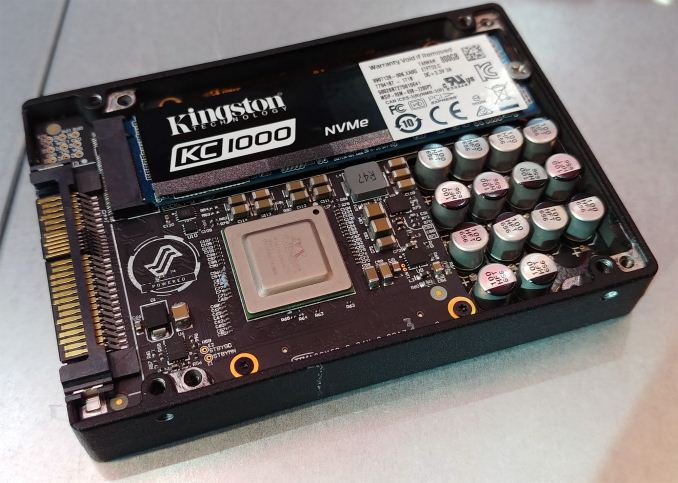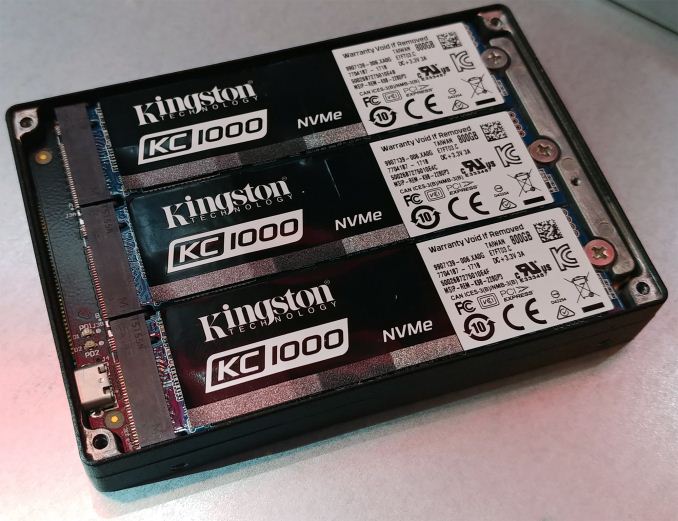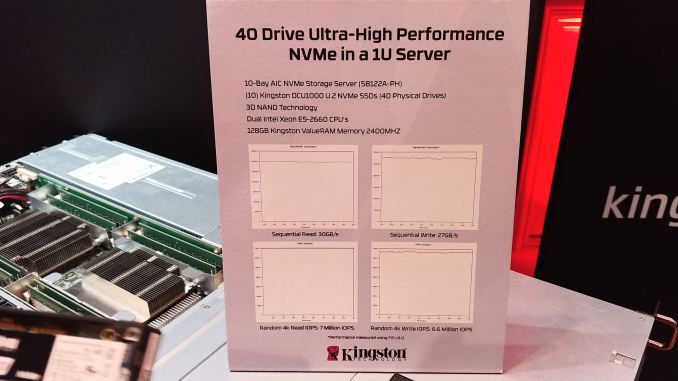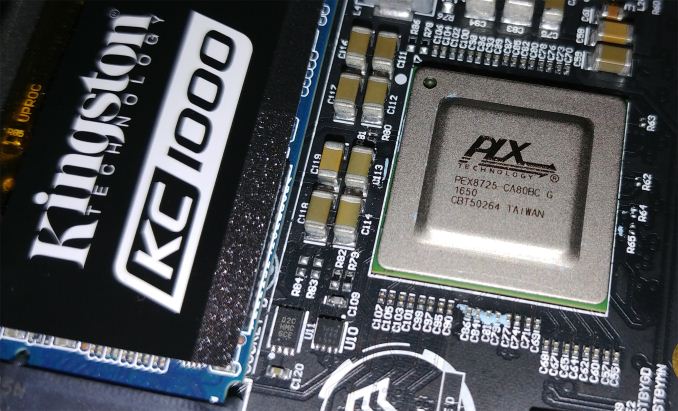Kingston at CES 2018: A 6.4 TB U.2 Enterprise SSD with Four M.2 Behind a PEX Chip
by Anton Shilov on January 19, 2018 1:00 PM EST
This year at CES, one of the interesting things at the Kingston suite was a demonstration of its new enterprise-grade DCU1000 SSDs. The current U.2 drives use four consumer-grade KC1000 M.2 SSDs behind a PCIe switch to offer up to 3.2 TB of useful capacity as well as a massive aggregated random read/write performance. The capacity of the overall drive at this point is limited to the M.2 drives being used.
The Kingston DCU1000 is a U.2 backplane internally, with four M.2 slots, integrated power loss protection, and the Avago ExpressLane PEX 8725 24-lane 10-port PCIe switch. The switch enables four M.2 drives to be used over a single U.2/SFF-8639 interface (PCIe 3.0 x4) and supports hot plugging. Kingston uses four KC1000 SSDs with custom firmware for its DCU1000 and plans to offer the U.2 drive in capacities of up to 3200 GB in the second quarter.
Kingston’s KC1000 SSDs are based on the Phison PS5007-E7 controller as well as planar MLC NAND. The drives are normally available in 240 GB, 480 GB and 960 GB configurations, but for the DCU1000 the manufacturer uses KC1000 800 GB SSDs. The lower capacity suggests that Kingston allocates a significant part of the onboard NAND memory for overprovisioning to compensate for using consumer-grade MLC.
The four drives installed into one DCU1000 are considered as independent software devices, but may operate in software RAID 0 mode to maximize performance. Obviously, the DCU1000 cannot hit anything higher than 3.8-3.9 GB/s with sequential reads due to PCIe 3.0 x4 limitation even in RAID 0, as any other U.2 drive. Meanwhile, Kingston advertises an aggregated read speed of 30 GB/s and an aggregated write speed of up to 27 GB/s for a 1U box containing 10 DCU1000 drives. As for random read reads, Kingston indicates that the box is capable 7M/6.6M read/write 4K IOPS (presumably at high queue depths).
While the Kingston DCU1000 can potentially offer a rather high aggregated performance, its capacity of 3.2 TB may be insufficient for certain mixed-use environments. Apparently, the company is already working on a special version of its next-gen consumer flagship drive based on 3D NAND that it will install into the DCU1000 to double capacity and random performance.
Usage of multiple M.2 SSDs to build high-capacity/high-performance server-/workstation-grade drives is nothing new: HP, Seagate and some other companies offer PCIe storage solutions employing multiple SSD modules. Kingston will be among the first well-known brands to use M.2 drives for a server-grade U.2 SSD. The architecture has its pros and cons. On the one hand, Kingston does not need to use enterprise-grade SSD controllers and procure huge amounts of enterprise-grade NAND flash specifically for server drives (that may sit in stock for a while). Besides, it can relatively quickly start using different drives (with proper firmware) with the DCU1000 backplane. On the other hand, enterprise controllers have a feature set that is better suited for datacenter environments and the PEX 8725 switch most probably eats most, if not all, the savings that Kingston gets by not using an enterprise-grade SSD controller.
The reason for designing such a drive, using a PCIe switch and M.2 drives, comes down to its intended use cases. U.2 drives are hot-swap, and being behind a PCIe switch allows the M.2 drives to also gain that functionality. The use-case presented to us in our briefing was one for video editing, where a film studio has a server/machine full of these drives, and when a days recording is done, the drives can be packed up and shipped to a visual effects studio (either by courier, or by placing an intern on a flight) to do their magic. This is commonly known as sneaker net, and offers much better bandwidth than transferring the raw 8K/16K footage through fat internet pipes. (Big data center services, like Google/Amazon, literally ship petabytes of data around using couriers, as the overall bandwidth is quicker.) The key to doing this is a combination of featureset (hotswappable, power loss protection) and storage density. While the first drives available will be in the 3.2 TB range, Kingston are ready and waiting to move forward with a 6.4 TB version when the M.2 drives double in capacity. One minute of uncompressed 16-bit 8K video comes in 284 GB, so the higher the capacity, the better. Having good speed and good random performance helps as well.
The KC1000 will be available to select customers of Kingston in the coming months. Pricing will depend on purchase volumes and other factors.
Related Reading
- Corsair Launches the Neutron NX500 1.6 TB PCIe SSD
- The Corsair Neutron NX500 (400GB) PCIe SSD Review: Big Card, Big Pricetag
- Phison at CES 2018: Thunderbolt SSDs, Second-Gen NVMe Controllers
- ASRock at CES 2018: Ultra Quad M.2 PCIe Card
- Seagate Introduces 10GB/s PCIe SSD And 60TB SAS SSD
- Seagate Announces PCIe x16 SSD Capable Of 10GB/s
Source: Kingston














12 Comments
View All Comments
bill.rookard - Saturday, January 20, 2018 - link
Agreed. Overall since the introduction of SSD's several years ago, you've seen a dramatic increase in raw transfer speed and IOPS vs regular HDDs, but the main sticking point is simply capacity. Your average HDD a few years ago was 2-3TB, your average SSD was a few hundred $$ for a 128GB SSD. Servers though have and hold large databases and lots of files, more than 128GB easily.Now, your max capacity (with certain exceptions) is now 6-10TB for HDDs and 2TB for SSDs for a few hundred $$. So - HDDs have increased their size by a factor of 2-3, while SSDs have increased their capacity by a factor 18. And if you merge a few behind a small raid controller, you have a capacity that approaches the size of your bigger HDDs while having that huge advantage in transfer speed and IOPS.
Your best HDD's do 200-300MB/sec alone... Even these 'limited' (??) drives have 10 times the speed and orders of magnitude higher IOPS.
A board with the right processor (ie: EPYC) with only 8x U2 connectors versus a x16 raid card with 8x SAS drives will still have double the raw bandwidth (32 PCIe lanes vs 16 PCIe lanes), and as far as utilized bandwidth, the x16 SAS setup would be lucky to hit a quarter of it's potential: 8 drives @ 300MB/sec = 2400MB/sec out of a total bandwidth of 15000MB/sec for an x16 slot.
Pinn - Saturday, January 20, 2018 - link
These comments are why I got to Anandtech.